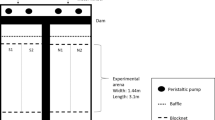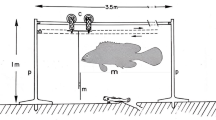Abstract
The gastropod snailNassarius obsoletus shows a dramatic self-burial response to the presence of crushed conspecifics. After it was shown that this burial alarm response could be reliably replicated in laboratory tests, a further characterization of the alarm substance was undertaken. Dilution experiments showed a very high response threshold resulting in a short effective radius of the substance in agreement with earlier field reports. Longevity experiments showed that the substance had lost some activity after 16 hr standing over marsh mud in sea water at room temperature; it became inactive after 24 hr. Superthreshold concentration in sea water was not necessary to keep the snails buried: Mud apparently provides an adsorption surface which can remain a stimulus source for previously unalarmed snails, and snails tend to remain buried after a short exposure to alarm substance, even when given a fresh environment. The substance is present in the snail's blood and tissues and is passively released. A potential natural predator capable of such release isCarcinus maenas, the green crab. Predator odor alone did not cause burial alarm responses. Preliminary chemical analysis indicates that the substance is water soluble, heat stable, and of high apparent molecular weight (over 100,000). A comparison with fish alarm substance and response is made in a discussion of the possible evolution of chemically triggered alarm responses. It is argued thatN. obsoletus may have developed an alarm response to an existing nonspecific substance rather than a true alarm pheromone.
Similar content being viewed by others
References
Atema, J., andBurd, G.D. 1975. A field study of chemotactic responses of the marine mud snail,Nassarius obsoletus.J. Chem. Ecol. 1(2):243–251.
Burohardt, G.M. 1970. Defining ‘communication’,in: J.W. Johnson, D.G. Moulton, and A. Turk (eds.). Advances in chemoreception. I. Communication by chemical signals. Appleton-Century-Crofts, New York.
Carr, W.E.S. 1974. Chemoreception and the role of proteins: A comparative study.Comp. Biochem. Physlol. 47A:559–566.
Eibl-Eibesfeldt, I. 1949. Über das Vorkommen von Schreckstoffen bei Erdkrötenquappen.Experientia 5:236.
Gandolfi, G., Mainardi, D., andRossi, A.C. 1968a. The fright reaction of the Zebra fish.Atti Soc. It. Sc. Nat. Mus. Civ. Milano 57:74–88.
Gandolfi, G., Mainardi, D., andRosi, A.C. 1968b. La reazione de paura e lo svantaggio individuale dei pesci alarmisti; esperimenti con modelli.Inst. Lombardo Rend. Sc. (B) 102:8–14.
Gore, R.H. 1966. Observations on the escape response inNassarius vibex (Say), (Mollusca: Gastropoda).Bull. Mar. Sci. 16(3):423–434.
Göz, H. 1941. Über den Art-und Individualgeruch bei Fische.Z. Vergl. Physiol. 29:1–45.
Heintz, E. 1954a. Actions répulsives exercées sur divers animaux par des substances contenues dans la peau ou le corps d'animaux de même espéce.C.R. Soc. Biol. (Paris) 148:585.
Heintz, E. 1954b. Nouvelles actions répulsives exercées par la peau ou le corps de divers animaux sur des animaux de même espèce.C.R. Soc. Biol. (Paris) 148:717.
Howe, N.R., andSheikh, Y.M. 1975. Anthopleurine: A sea anemone alarm pheromone.Science 189:386–388.
Hrbácek, J. 1950. On the flight reaction of tadpoles of the common toad caused by chemical substances.Experientia 6:100–101.
Kempendorff, W. 1942. Ueber das Fluchtphänomen und die Chemorezeption vonHelisoma (Taphius) nigricans Spix.Arch. Molluskenk. 74:1–27.
Kulzer, E. 1954. Untersuchung über die Schreckreaktion bei Erdkrötenquappen (Bufo bufo L.).Z. Vergl. Physiol. 36:443–463.
Pfeiffer, W. 1963. Alarm substances.Experientia 19:113–123.
Pfeiffer, W., andLemke, J. 1973. Untersuchungen zur Isolierung und Identifizierung des Schreckstoffes aus der Haut der Elritze,Phoxinus phoxinus (L.).J. Comp. Physiol. 82:407–410.
Reutter, K., andPfeiffer, W. 1973. Fluoreszenzmikroskopischer Nachweis des Schreck-stoffes in den Schreckstoffzellen der Elritze,Phoxinus phoxinus (L.).J. Comp. Physiol. 82:411–418.
Snyder, N.F.R. 1966. An alarm reaction of aquatic gastropods to intraspecific extract. Ph.D. thesis, Cornell University, Ithaca, New York.
Snyder, N.F.R. 1967. An alarm reaction of aquatic gastropods to intraspecific extract.Cornell Univ. Agr. Exp. Sta. Mem. 403.
Snyder, N.F.R., andSnyder, H.A. 1970. Alarm response ofDiadema antillarum.Science 168:276–278.
Snyder, N.F.R., andSnyder, H.A. 1971. Defenses of the Florida apple snailPomacea paludosa.Behavior 40(3):175–214.
Stenzler, D., andAtema, J. 1976. Alarm response of the marine mud snail,Nassarius obsoletus: Specificity and behavioral priority.J. Chem. Ecol. 3(2):159–171.
Von Frisch, K. 1938. Zur Psychologie des Fisch-Schwarmes.Naturwissenschaften 26:601–606.
von Frisch, K. 1941a. Die Bedeutung des Geruchssinnes im Leben der Fische.Naturwissenschaften 29:321–333.
von Frisch, K. 1941b. Über einen Schreckstoff der Fischhaut und seine biologische Bedeutung.Z. Vergl. Physiol. 29:46–145.
Author information
Authors and Affiliations
Additional information
This paper is based in part upon a thesis submitted by D.S. to Boston University for the degree of Master of Arts.
Rights and permissions
About this article
Cite this article
Atema, J., Stenzler, D. Alarm substance of the marine mud snail,Nassarius obsoletus: Biological characterization and possible evolution. J Chem Ecol 3, 173–187 (1977). https://doi.org/10.1007/BF00994144
Received:
Revised:
Issue Date:
DOI: https://doi.org/10.1007/BF00994144




